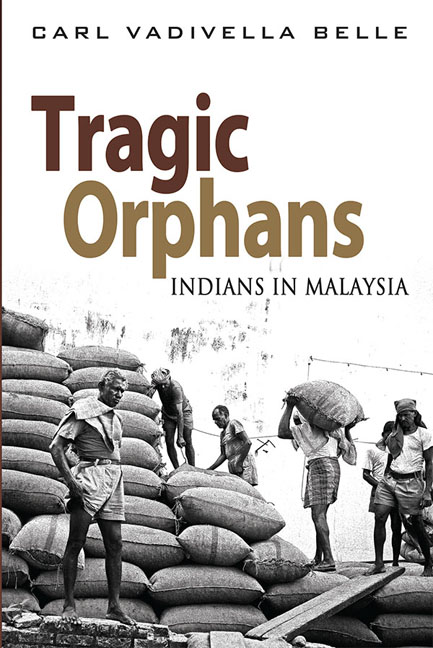Book contents
- Frontmatter
- Contents
- Acknowledgements
- List of Abbreviations
- Introduction
- 1 The Malay Peninsula: Early History, Melaka and the Colonial Setting
- 2 European Colonialism and the Malay Peninsula
- 3 India and the Development of British Ideologies of Empire
- 4 British Governance of Malaya
- 5 Slavery and Indentured Labour
- 6 Indian Indentured Labour in Malaya
- 7 Kangany Labour in Malaya
- 8 Other Indian Immigration
- 9 Indian Political Development to 1941
- 10 The Japanese Invasion, Subhas Chandra Bose and Indian Wartime Nationalism
- 11 The Post–war Period: Reform and Repression: 1945–48
- 12 From Federation to Merdeka
- 13 From Malaya to Malaysia: Singapore, 13 May and the New Economic Policy
- 14 The Mahathir Years: A Changing Malaysian Landscape
- 15 Abdullah Badawi, Islamization, and the Rise of Hindraf
- 16 Najib and 1Malaysia: A New Deal?
- Conclusions
- Bibliography
- Index
11 - The Post–war Period: Reform and Repression: 1945–48
Published online by Cambridge University Press: 06 June 2017
- Frontmatter
- Contents
- Acknowledgements
- List of Abbreviations
- Introduction
- 1 The Malay Peninsula: Early History, Melaka and the Colonial Setting
- 2 European Colonialism and the Malay Peninsula
- 3 India and the Development of British Ideologies of Empire
- 4 British Governance of Malaya
- 5 Slavery and Indentured Labour
- 6 Indian Indentured Labour in Malaya
- 7 Kangany Labour in Malaya
- 8 Other Indian Immigration
- 9 Indian Political Development to 1941
- 10 The Japanese Invasion, Subhas Chandra Bose and Indian Wartime Nationalism
- 11 The Post–war Period: Reform and Repression: 1945–48
- 12 From Federation to Merdeka
- 13 From Malaya to Malaysia: Singapore, 13 May and the New Economic Policy
- 14 The Mahathir Years: A Changing Malaysian Landscape
- 15 Abdullah Badawi, Islamization, and the Rise of Hindraf
- 16 Najib and 1Malaysia: A New Deal?
- Conclusions
- Bibliography
- Index
Summary
Although the Japanese surrender in Malaya came into effect on 19 August, it was not until 4 September that the main Allied landings were made in Singapore. On 9 September, Louis Mountbatten, Supreme Commander, South East Asian Command (SEAC), accepted the final surrender of 70,000 Japanese troops. The Japanese used the intervening period to burn archives, to murder witnesses to their atrocities, and to falsify documents.
THE MPAJA AND SINO–MALAY RACIAL CLASHES
In Chapter 10 we noted that Japanese policies on ethnicity served to solidify incipient “racial” identities and exacerbated Sino-Malay rivalry and distrust. Japanese propaganda had highlighted Chinese “exploitation” of impoverished Malays and Japanese championship of Malay interests. Post-war violence was to deepen and indeed entrench inter-ethnic cleavage.
The unexpected swiftness of the Japanese capitulation left an interregnum of several weeks — months in some districts — in which there was a complete absence of government control. In many areas law and order collapsed, and diverse groups throughout the country took matters into their own hands. Mobs exacted revenge against those who had collaborated, or were rumoured to have collaborated, with the Japanese, and there was a spate of lynching, murder, torture and other acts of violence.
Under the agreement signed at Blantan in December 1943, the MPAJA had allied with the British and agreed to accept SEAC direction. With the Japanese surrender, the MPAJA, hailed as heroes among the squatter population (and generally admired by many urban Chinese as well), and numbering between 5,000 and 7,000 armed members, now emerged from the jungle and signalled their intention of maintaining order within Malaya until the arrival of British and Allied forces. Ultimately approximately seventy per cent of small towns and villages throughout Malaya came under MPAJA control.
The MPAJA instigated a regime of savage and arbitrary reprisals against known as well as putative collaborators. Many of those dealt with by MPAJA tribunals were arraigned as a result of unfounded and trumpedup charges (often provoked by the personal grievances of informers and agents), and were convicted on the basis of uncorroborated and even contrived evidence. Most of the accused were Malays, who, as noted in Chapter 10, had been actively recruited by the Japanese.
- Type
- Chapter
- Information
- Tragic OrphansIndians in Malaysia, pp. 225 - 264Publisher: ISEAS–Yusof Ishak InstitutePrint publication year: 2014

